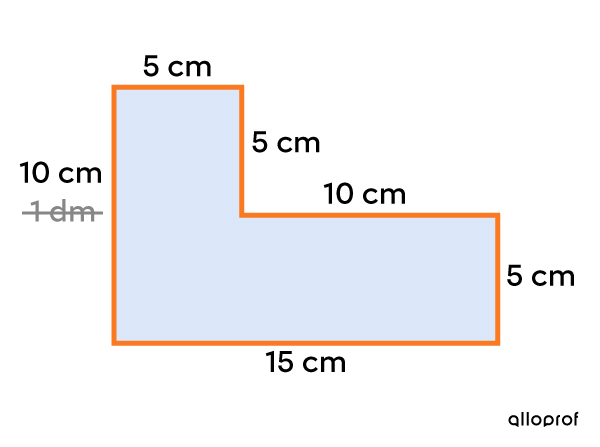Slug (identifier)
perimeter-elementary
Equivalent file in the opposite grade group
Content
Title (level 2)
3rd and 4th grade
Title slug (identifier)
third-and-fourth-grade
Contenu
Contenu
Content
Content
Corps
Perimeter is the measurement of the contour or outline of a plane figure or surface.
Example:
The perimeter of the figure corresponds to the measurement of the orange line.
Title
How do we calculate the perimeter?
Content
Corps
The perimeter of a figure is obtained by adding all the side measurements.
Content
Corps
When calculating the perimeter, make sure that only one unit of measurement is used. If not, convert the units before doing the calculations.
Example:
Content
Corps
What is the perimeter of this figure?
Corps
-
I check that the same unit of measurement is used. If not, I must convert it.
To learn how, see the concept sheet Converting Units for Measuring Length.
Since the other units are in cm, I convert 1 dm to cm.
|
 |
-
I add the lengths of all the figure’s sides to find the perimeter.
5 cm + 5 cm + 10 cm + 5 cm + 15 cm + 10 cm = 50 cm
|
The perimeter is 50 cm.
Title
How do we find a missing measurement when the perimeter is known?
Content
Corps
To find the missing measurement of a plane figure from a given perimeter, a subtraction is required.
To find out how to find a missing term in an addition, see the concept sheet Finding a Missing Term in an Addition.
Content
Corps
Find the missing measurement in this figure.
Corps
-
I know I have to add the side measurements to find the perimeter.
10 mm + 20 mm + 30 mm + 20 mm + ? mm + 40 mm + 60 mm + 40 mm = 240 mm
|
-
I subtract the known side measurements from the perimeter to find the missing side.
240 mm - 10 mm - 20 mm - 30 mm - 20 mm - 40 mm - 60 mm - 40 mm = 20 mm
|
The missing side measurement of the perimeter is 20 mm.
Contenu
Content
Links
Title
Finding a Missing Term in an Addition
Title
Units for Measuring Length
Title
Converting Units for Measuring Length




